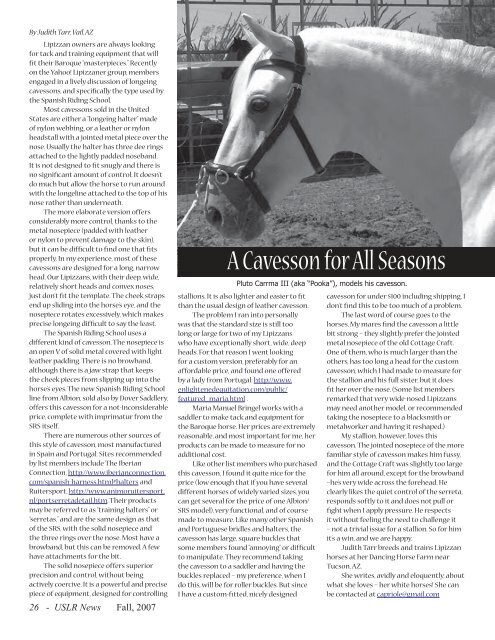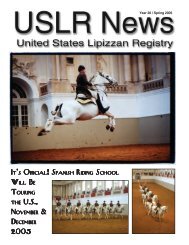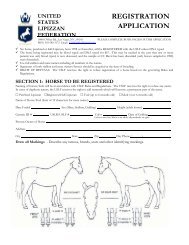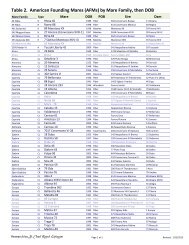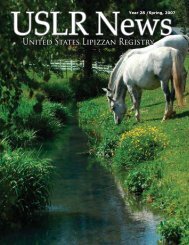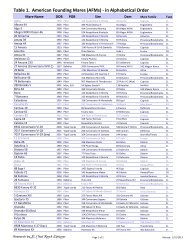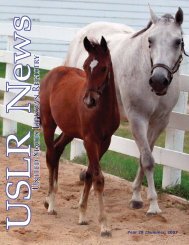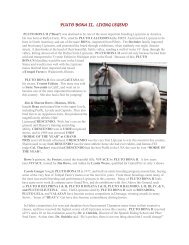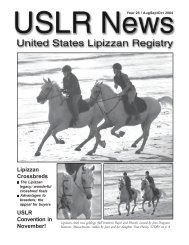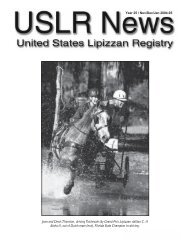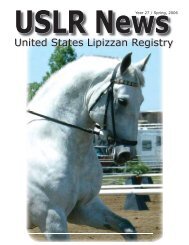Fall 2007 - United States Lipizzan Federation
Fall 2007 - United States Lipizzan Federation
Fall 2007 - United States Lipizzan Federation
You also want an ePaper? Increase the reach of your titles
YUMPU automatically turns print PDFs into web optimized ePapers that Google loves.
By Judith Tarr, Vail, AZ<br />
<strong>Lipizzan</strong> owners are always looking<br />
for tack and training equipment that will<br />
fit their Baroque “masterpieces.” Recently<br />
on the Yahoo! <strong>Lipizzan</strong>er group, members<br />
engaged in a lively discussion of longeing<br />
cavessons, and specifically the type used by<br />
the Spanish Riding School.<br />
Most cavessons sold in the <strong>United</strong><br />
<strong>States</strong> are either a “longeing halter” made<br />
of nylon webbing, or a leather or nylon<br />
headstall with a jointed metal piece over the<br />
nose. Usually the halter has three dee rings<br />
attached to the lightly padded noseband.<br />
It is not designed to fit snugly and there is<br />
no significant amount of control. It doesn’t<br />
do much but allow the horse to run around<br />
with the longeline attached to the top of his<br />
nose rather than underneath.<br />
The more elaborate version offers<br />
considerably more control, thanks to the<br />
metal nosepiece (padded with leather<br />
or nylon to prevent damage to the skin),<br />
but it can be difficult to find one that fits<br />
properly. In my experience, most of these<br />
cavessons are designed for a long, narrow<br />
head. Our <strong>Lipizzan</strong>s, with their deep, wide,<br />
relatively short heads and convex noses,<br />
just don’t fit the template. The cheek straps<br />
end up sliding into the horse’s eye, and the<br />
nosepiece rotates excessively, which makes<br />
precise longeing difficult to say the least.<br />
The Spanish Riding School uses a<br />
different kind of cavesson. The nosepiece is<br />
an open V of solid metal covered with light<br />
leather padding. There is no browband,<br />
although there is a jaw strap that keeps<br />
the cheek pieces from slipping up into the<br />
horse’s eyes. The new Spanish Riding School<br />
line from Albion, sold also by Dover Saddlery,<br />
offers this cavesson for a not-inconsiderable<br />
price, complete with imprimatur from the<br />
SRS itself.<br />
There are numerous other sources of<br />
this style of cavesson, most manufactured<br />
in Spain and Portugal. Sites recommended<br />
by list members include The Iberian<br />
Connection, http://www.iberianconnection.<br />
com/spanish-harness.html#halters and<br />
Ruitersport, http://www.animoruitersport.<br />
nl/portserretadetail.htm. Their products<br />
may be referred to as “training halters” or<br />
“serretas,” and are the same design as that<br />
of the SRS, with the solid nosepiece and<br />
the three rings over the nose. Most have a<br />
browband, but this can be removed. A few<br />
have attachments for the bit.<br />
The solid nosepiece offers superior<br />
precision and control, without being<br />
actively coercive. It is a powerful and precise<br />
piece of equipment, designed for controlling<br />
26 - USLR News <strong>Fall</strong>, <strong>2007</strong><br />
A Cavesson for All Seasons<br />
Pluto Carrma III (aka “Pooka”), models his cavesson.<br />
stallions. It is also lighter and easier to fit<br />
than the usual design of leather cavesson.<br />
The problem I ran into personally<br />
was that the standard size is still too<br />
long or large for two of my <strong>Lipizzan</strong>s<br />
who have exceptionally short, wide, deep<br />
heads. For that reason I went looking<br />
for a custom version, preferably for an<br />
affordable price, and found one offered<br />
by a lady from Portugal: http://www.<br />
enlightenedequitation.com/public/<br />
featured_maria.html .<br />
Maria Manuel Bringel works with a<br />
saddler to make tack and equipment for<br />
the Baroque horse. Her prices are extremely<br />
reasonable, and most important for me, her<br />
products can be made to measure for no<br />
additional cost.<br />
Like other list members who purchased<br />
this cavesson, I found it quite nice for the<br />
price (low enough that if you have several<br />
different horses of widely varied sizes, you<br />
can get several for the price of one Albion/<br />
SRS model), very functional, and of course<br />
made to measure. Like many other Spanish<br />
and Portuguese bridles and halters, the<br />
cavesson has large, square buckles that<br />
some members found “annoying” or difficult<br />
to manipulate. They recommend taking<br />
the cavesson to a saddler and having the<br />
buckles replaced – my preference, when I<br />
do this, will be for roller buckles. But since<br />
I have a custom-fitted, nicely designed<br />
cavesson for under $100 including shipping, I<br />
don’t find this to be too much of a problem.<br />
The last word of course goes to the<br />
horses. My mares find the cavesson a little<br />
bit strong – they slightly prefer the jointed<br />
metal nosepiece of the old Cottage Craft.<br />
One of them, who is much larger than the<br />
others, has too long a head for the custom<br />
cavesson, which I had made to measure for<br />
the stallion and his full sister, but it does<br />
fit her over the nose. (Some list members<br />
remarked that very wide-nosed <strong>Lipizzan</strong>s<br />
may need another model, or recommended<br />
taking the nosepiece to a blacksmith or<br />
metalworker and having it reshaped.)<br />
My stallion, however, loves this<br />
cavesson. The jointed nosepiece of the more<br />
familiar style of cavesson makes him fussy,<br />
and the Cottage Craft was slightly too large<br />
for him all around, except for the browband<br />
–he’s very wide across the forehead. He<br />
clearly likes the quiet control of the serreta,<br />
responds softly to it and does not pull or<br />
fight when I apply pressure. He respects<br />
it without feeling the need to challenge it<br />
– not a trivial issue for a stallion. So for him<br />
it’s a win, and we are happy.<br />
Judith Tarr breeds and trains <strong>Lipizzan</strong><br />
horses at her Dancing Horse Farm near<br />
Tucson, AZ.<br />
She writes, avidly and eloquently, about<br />
what she loves – her white horses! She can<br />
be contacted at capriole@gmail.com


